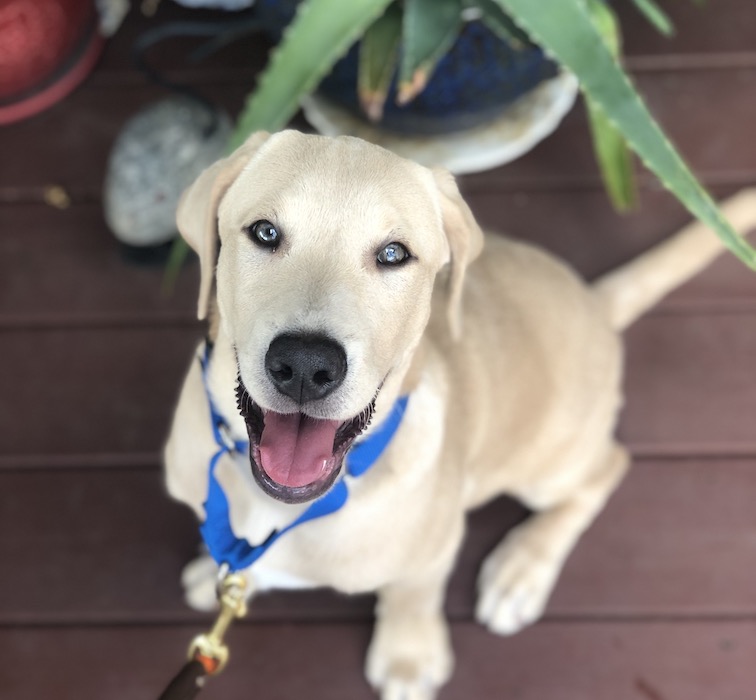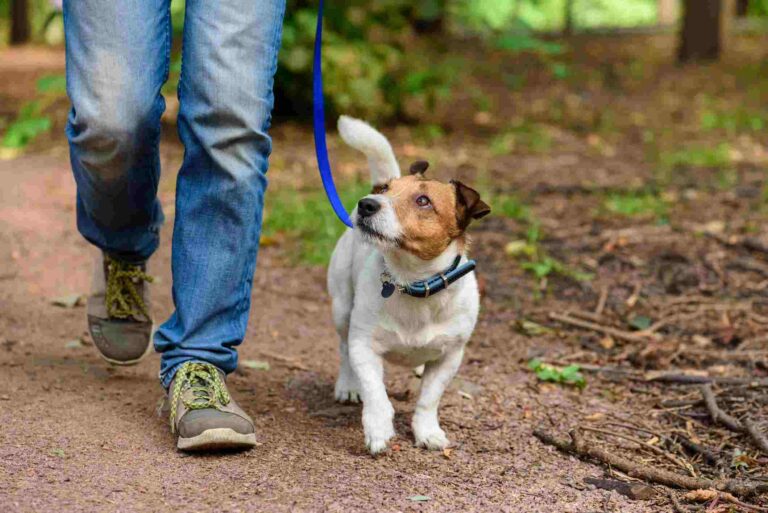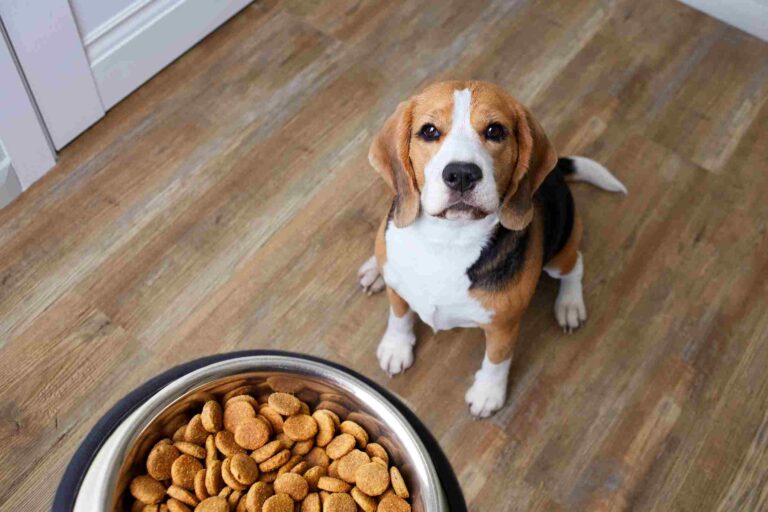Bringing a new puppy home can be equally as exciting as it is challenging. Those first days and nights are full of lots of snuggles, adjustments, and more snuggles. As the days pass and your puppy gets a little older, even by just a few weeks, you may start to notice them engaging in more attention-seeking behaviors towards you. Jumping, play biting, and barking at you to name a few! It is very normal for your puppy to begin seeking out ways to earn your attention as early as 10-12 weeks, however, did you know you can start teaching your puppy obedience and manners from Day 1? There are alternative ways to teach your puppy how to ask for your attention. One of the most simple and our trainer’s go-to is teaching the “Auto-sit”.
What is an “auto-sit”?
An auto-sit is a learned behavior in which your puppy’s automatic response becomes them offering a sit, without being asked for it when seeking attention or other forms of reinforcement. The key to developing the auto-sit as a strong automatic behavior in your puppy is to not verbally cue them. Instead, you will begin to increase the likelihood of your puppy offering you a sit naturally through repetition and reinforcement. To do this, you will teach your puppy that as they “work” for you and offer behaviors such as the auto-sit, over time they learn how to access attention and reinforcement without cue AND ask for it in a more desired way to you.
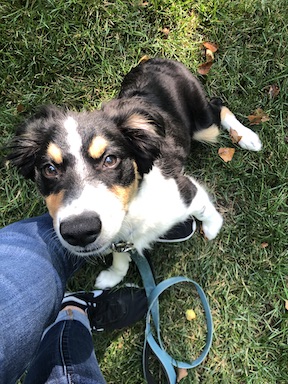
How to start teaching the auto-sit
To start, you will need a leash, a fitted collar, kibble or treats, and a treat pouch. If you are still in need of any of these supplies, we have a puppy supply list for you to check out first.
1st Step: Luring
Start with having your puppy drag a leash and collar, and your treat pouch clipped to your back hip with treats or kibble ready to go. Get your puppy interested in you by placing a piece of kibble in between your fingers and waving it in front of their nose.
- When they notice the food, with an upward-facing palm, move the food up towards the sky, in a similar motion as if you were zipping up a zipper.
- As they follow the treat, continue raising it up above their head until their weight shifts and they place their bottom on the floor.
- As soon as their bottom touches the floor, deliver praise, pet your puppy with one hand, and deliver an immediate treat with the other hand.
- As long as your puppy continues to stay seated, continue to deliver physical attention. If they get up out of the sit, immediately stop giving attention.
- Repeat, repeat, repeat
If you find your puppy is constantly trying to jump up on you, you can step on their leash to prevent them from jumping up, just until they get the hang of the game.
2nd Step: Fading treats
Once your puppy has the hang of sitting for the treat and is beginning to offer the behavior quickly and without a cue, this is your sign to start eliminating the treats. Keep your hand in the same position as before, but no treat in your hand. We recommend keeping your treats in your pouch on your back hip or placing the pouch on a nearby table for quick access. Follow the same upwards zipper motion as before.
- When your puppy sits for you, deliver praise, pet with one hand, and grab a treat and feed with the other after you have delivered physical attention already.
- After a few days, as your puppy begins to offer you sits versus seeking out a hand cue, you can begin to use physical attention and praise as reinforcement and fade out the use of treats altogether.
If your puppy is struggling, you may need to use treats just a little bit longer.
3rd Step: Holding the auto-sit
Now that your puppy understands the basic steps of how to offer an auto-sit, you can begin to work on how long your puppy holds the sit. This will help to reduce the likelihood of other unwanted behaviors such as jumping, play biting or barking.
- To increase the amount of time they are sitting, start by rewarding them for sitting for 1-2 seconds, then 3, 5, 10, etc.
- Continue to pet them and feed them for each increased amount of time they remain sitting.
- If they get up at any time, stop delivering treats and attention.
- When they offer another sit, begin another trial and slowly increase and reinforce the duration.
It is best for their learning to avoid saying “sit” if they aren’t offering a sit again. If they are a little slow on offering, wait for at least 10 seconds to see if they will offer another sit. If they do not, deliver the hand signal. Just like with teaching the initial auto-sit, once your puppy picks up the game and is successfully staying in a sit, you can begin to fade out the number of treats you are using and focus on praise and physical attention as reinforcement.
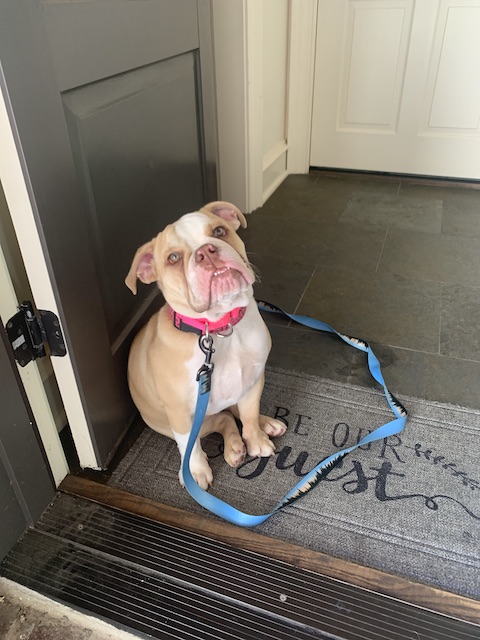
Auto-sit in action
Now that your puppy has learned the foundation of the auto-sit, it’s time to up the difficulty and work on generalizing the auto-sit to others in the household, children, and guests.
When having a guest over, keep the leash on your puppy so that you can manage other less appropriate behaviors such as jumping. You may need to step on the leash to prevent jumping on guests initially. We would also recommend giving your guests treats and reintroducing the lure just to start. This will get your puppy successful with novel guests early and once your puppy begins to generalize to other people, you can fade out the food just as before. If you are on a walk and a stranger approaches wanting to pet your puppy, use the same tips as above. Prevent jumping and encourage and reinforce an auto-sit. It may take 3-5+ guests or strangers for your puppy to really generalize offering sits to strangers without getting overexcited.
Don’t get discouraged if your puppy is overly excited, staying consistent on reinforcement in more difficult situations is key! If after trying out auto-sits for yourself, you have additional questions or need help generalizing this or other behaviors to more difficult situations, consider reaching out to your local behavior consultant! We recommend one that offers private in-home training and can target your specific needs.
